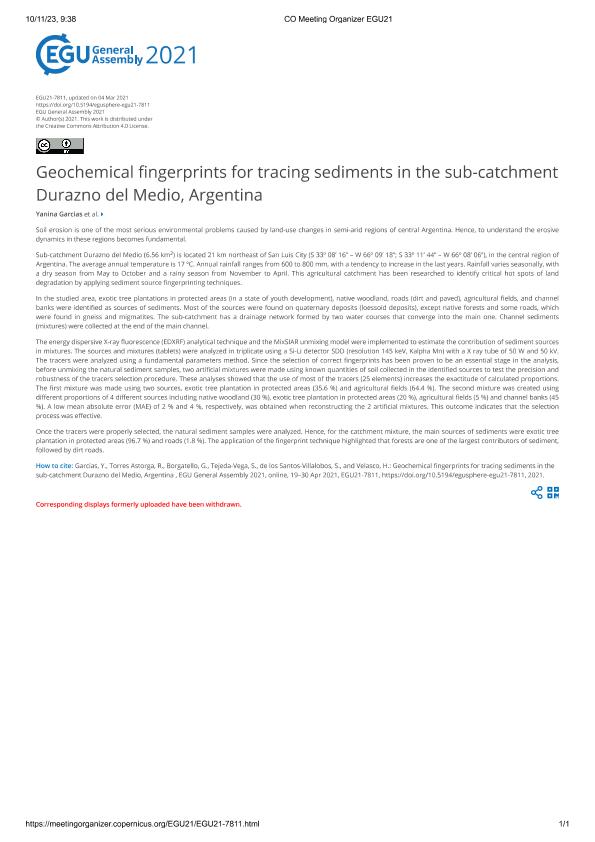Mostrar el registro sencillo del ítem
dc.contributor.author
Garcias Paez, Yanina Vanesa

dc.contributor.author
Torres Astorga, Romina Vanesa

dc.contributor.author
Borgatello, Gisela Natalia

dc.contributor.author
Tejeda, Samuel
dc.contributor.author
de los Santos Villalobos, Sergio
dc.contributor.author
Velasco, Ricardo Hugo

dc.date.available
2023-11-10T12:39:52Z
dc.date.issued
2021
dc.identifier.citation
Geochemical fingerprints for tracing sediments in the sub-catchment Durazno del Medio, Argentina; EGU General Assembly 2021; Viena; Austria; 2021; 1-2
dc.identifier.uri
http://hdl.handle.net/11336/217709
dc.description.abstract
Soil erosion is one of the most serious environmental problems caused by land-use changes in semi-arid regions of central Argentina. Hence, to understand the erosive dynamics in these regions becomes fundamental. Sub-catchment Durazno del Medio (6.56 km2) is located 21 km northeast of San Luis City (S 33º 08’ 16” – W 66º 09’ 18”; S 33º 11’ 44” – W 66º 08’ 06”), in the central region of Argentina. The average annual temperature is 17 ºC. Annual rainfall ranges from 600 to 800 mm, with a tendency to increase in the last years. Rainfall varies seasonally, with a dry season from May to October and a rainy season from November to April. This agricultural catchment has been researched to identify critical hot spots of land degradation by applying sediment source fingerprinting techniques. In the studied area, exotic tree plantations in protected areas (in a state of youth development), native woodland, roads (dirt and paved), agricultural fields, and channel banks were identified as sources of sediments. Most of the sources were found on quaternary deposits (loessoid deposits), except native forests and some roads, which were found in gneiss and migmatites. The sub-catchment has a drainage network formed by two water courses that converge into the main one. Channel sediments (mixtures) were collected at the end of the main channel. The energy dispersive X-ray fluorescence (EDXRF) analytical technique and the MixSIAR unmixing model were implemented to estimate the contribution of sediment sources in mixtures. The sources and mixtures (tablets) were analyzed in triplicate using a Si-Li detector SDD (resolution 145 keV, Kalpha Mn) with a X ray tube of 50 W and 50 kV. The tracers were analyzed using a fundamental parameters method. Since the selection of correct fingerprints has been proven to be an essential stage in the analysis, before unmixing the natural sediment samples, two artificial mixtures were made using known quantities of soil collected in the identified sources to test the precision and robustness of the tracers selection procedure. These analyses showed that the use of most of the tracers (25 elements) increases the exactitude of calculated proportions. The first mixture was made using two sources, exotic tree plantation in protected areas (35.6 %) and agricultural fields (64.4 %). The second mixture was created using different proportions of 4 different sources including native woodland (30 %), exotic tree plantation in protected areas (20 %), agricultural fields (5 %) and channel banks (45 %). A low mean absolute error (MAE) of 2 % and 4 %, respectively, was obtained when reconstructing the 2 artificial mixtures. This outcome indicates that the selection process was effective. Once the tracers were properly selected, the natural sediment samples were analyzed. Hence, for the catchment mixture, the main sources of sediments were exotic tree plantation in protected areas (96.7 %) and roads (1.8 %). The application of the fingerprint technique highlighted that forests are one of the largest contributors of sediment, followed by dirt roads.
dc.format
application/pdf
dc.language.iso
eng
dc.publisher
European Geosciences Union
dc.rights
info:eu-repo/semantics/openAccess
dc.rights.uri
https://creativecommons.org/licenses/by/2.5/ar/
dc.subject
erosion
dc.subject
fingerprints
dc.subject
geochemical
dc.subject
tracing
dc.subject.classification
Otras Ciencias de la Tierra y relacionadas con el Medio Ambiente

dc.subject.classification
Ciencias de la Tierra y relacionadas con el Medio Ambiente

dc.subject.classification
CIENCIAS NATURALES Y EXACTAS

dc.title
Geochemical fingerprints for tracing sediments in the sub-catchment Durazno del Medio, Argentina
dc.type
info:eu-repo/semantics/publishedVersion
dc.type
info:eu-repo/semantics/conferenceObject
dc.type
info:ar-repo/semantics/documento de conferencia
dc.date.updated
2023-02-16T11:03:02Z
dc.journal.pagination
1-2
dc.journal.pais
Alemania

dc.journal.ciudad
Göttingen
dc.description.fil
Fil: Garcias Paez, Yanina Vanesa. Consejo Nacional de Investigaciones Científicas y Técnicas. Centro Científico Tecnológico Conicet - San Luis. Instituto de Matemática Aplicada de San Luis "Prof. Ezio Marchi". Universidad Nacional de San Luis. Facultad de Ciencias Físico, Matemáticas y Naturales. Instituto de Matemática Aplicada de San Luis "Prof. Ezio Marchi"; Argentina
dc.description.fil
Fil: Torres Astorga, Romina Vanesa. Consejo Nacional de Investigaciones Científicas y Técnicas. Centro Científico Tecnológico Conicet - San Luis. Instituto de Matemática Aplicada de San Luis "Prof. Ezio Marchi". Universidad Nacional de San Luis. Facultad de Ciencias Físico, Matemáticas y Naturales. Instituto de Matemática Aplicada de San Luis "Prof. Ezio Marchi"; Argentina
dc.description.fil
Fil: Borgatello, Gisela Natalia. Consejo Nacional de Investigaciones Científicas y Técnicas. Centro Científico Tecnológico Conicet - San Luis. Instituto de Matemática Aplicada de San Luis "Prof. Ezio Marchi". Universidad Nacional de San Luis. Facultad de Ciencias Físico, Matemáticas y Naturales. Instituto de Matemática Aplicada de San Luis "Prof. Ezio Marchi"; Argentina
dc.description.fil
Fil: Tejeda, Samuel. Instituto Nacional de Investigaciones Nucleares; México
dc.description.fil
Fil: de los Santos Villalobos, Sergio. Instituto Tecnológico de Sonora; México
dc.description.fil
Fil: Velasco, Ricardo Hugo. Consejo Nacional de Investigaciones Científicas y Técnicas. Centro Científico Tecnológico Conicet - San Luis. Instituto de Matemática Aplicada de San Luis "Prof. Ezio Marchi". Universidad Nacional de San Luis. Facultad de Ciencias Físico, Matemáticas y Naturales. Instituto de Matemática Aplicada de San Luis "Prof. Ezio Marchi"; Argentina
dc.relation.alternativeid
info:eu-repo/semantics/altIdentifier/url/https://meetingorganizer.copernicus.org/EGU21/EGU21-7811.html
dc.relation.alternativeid
info:eu-repo/semantics/altIdentifier/doi/https://doi.org/10.5194/egusphere-egu21-7811
dc.conicet.rol
Autor

dc.conicet.rol
Autor

dc.conicet.rol
Autor

dc.conicet.rol
Autor

dc.conicet.rol
Autor

dc.conicet.rol
Autor

dc.coverage
Internacional
dc.type.subtype
Conferencia
dc.description.nombreEvento
EGU General Assembly 2021
dc.date.evento
2021-04-19
dc.description.ciudadEvento
Viena
dc.description.paisEvento
Austria

dc.type.publicacion
Journal
dc.description.institucionOrganizadora
European Geosciences Union
dc.source.revista
vEGU21: Gather Online
dc.date.eventoHasta
2021-04-30
dc.type
Conferencia
Archivos asociados
